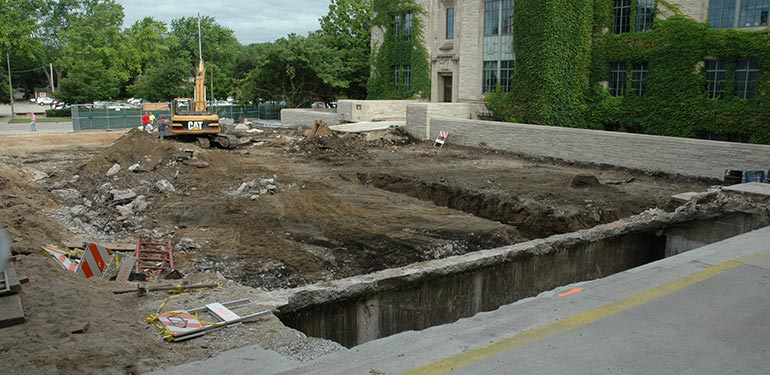Consulting Civil Engineering Companies Providing Geotechnical Solutions
Wiki Article
How Consulting Engineers Enhance Geotechnical Design Projects: Insights Into Their Competence, Approaches, and Collaborative Approaches
Consulting engineers are pivotal in enhancing geotechnical design jobs, applying their specialized expertise to navigate the complexities of subsurface conditions. Their joint approaches foster interaction amongst diverse job stakeholders, inevitably shaping the job's trajectory.Duty of Consulting Engineers
The expertise of seeking advice from engineers in geotechnical design is basic to the successful execution of building and construction projects. These experts play a pivotal function in examining dirt and rock buildings, which are vital factors influencing style and building and construction decisions. By carrying out extensive website investigations, speaking with designers collect crucial information that educates the style process, guaranteeing projects are improved steady and ideal ground.Consulting engineers likewise supply very useful understandings right into danger administration (geotechnical geologist). They determine prospective geotechnical hazards, such as landslides, soil liquefaction, and negotiation concerns, making it possible for stakeholders to carry out efficient mitigation strategies. Their competence aids in optimizing foundation layouts, which can bring about substantial expense savings and enhanced safety and security
In addition, getting in touch with designers work as a crucial link between task owners, architects, and specialists. Their capability to equate complex geotechnical data right into workable recommendations fosters cooperation and promotes notified decision-making throughout the job lifecycle. This multidisciplinary technique not only improves project efficiency yet additionally ensures conformity with governing criteria and finest methods.
Secret Approaches in Geotechnical Engineering

One key approach is website investigation, which includes performing field examinations and laboratory analyses to gather information on subsurface problems. Strategies such as Requirement Infiltration Screening (SPT) and Cone Infiltration Testing (CPT) are commonly used to review dirt stratigraphy and toughness. In addition, geophysical techniques, consisting of seismic and electric resistivity surveys, supply non-invasive ways to examine subsurface features.
An additional critical methodology is numerical modeling, which makes it possible for designers to imitate numerous scenarios and predict exactly how soil-structure communications will behave under different loading conditions. Limited Aspect Evaluation (FEA) is a typical technique utilized in this context.
Additionally, the layout of structures, preserving frameworks, and earthworks counts greatly on these methodologies - geotechnical geologist. By integrating advanced analytical tools with area data, getting in touch with engineers can create tailored solutions that attend to certain job obstacles, inevitably adding to the security and safety and security of building and construction projects
Importance of Soil Evaluation
Soil analysis acts as a fundamental aspect in geotechnical engineering, offering necessary understandings into the physical and chemical residential properties of soil necessary for efficient building planning. Recognizing soil features is crucial for establishing its load-bearing capability, water drainage behavior, and capacity for negotiation or instability. Thorough dirt investigations, consisting of tasting and laboratory screening, aid determine specifications such as dirt type, wetness web content, thickness, and shear strength.
These evaluations educate the option of appropriate construction methods and materials, eventually influencing project safety a knockout post and longevity. Cohesive soils may require various structure styles compared to granular dirts, necessitating customized engineering solutions. Dirt evaluation help in determining impurities that can pose threats to human wellness or the environment, enabling for the growth of mitigation methods.
Including soil analysis into the onset of task growth assists to reduce unanticipated obstacles, ensuring that designers can expect and address prospective problems prior to they escalate. By developing a detailed understanding of the site conditions, seeking advice from engineers can enhance layout effectiveness and reduce costs, thus enhancing the overall success of geotechnical design projects.
Collaborative Approaches in Projects
Successful geotechnical projects frequently depend upon collective strategies that unite diverse expertise from different self-controls. Reliable cooperation amongst seeking advice from designers, geologists, environmental scientists, and construction professionals is crucial for attending to complicated challenges and enhancing task outcomes. By leveraging the distinct abilities and knowledge of each group member, tasks can take advantage of an alternative understanding of the site problems, regulatory needs, and design constraints.Routine communication and interdisciplinary meetings help with the sharing of insights and cultivate a society of synergy. These collaborative initiatives make it possible for the identification of possible threats early in the task lifecycle, permitting prompt mitigation strategies. Including comments from stakeholders, including regional communities and regulatory companies, guarantees that all point of views are thought about, improving project acceptance and compliance.
Additionally, the integration of innovative technologies, such as Geographic Info Solution (GIS) and Building Details Modeling (BIM), further boosts partnership. These tools permit for the real-time sharing of information and visualization of geotechnical conditions, advertising educated decision-making. Eventually, a collaborative approach not just enhances task execution but also lays the structure for ingenious remedies to complicated geotechnical engineering challenges.
Effect on Job End Results

Consulting designers use sophisticated methods such as danger analysis and anticipating modeling, which improve the precision of project projections. Their capability to incorporate ingenious innovations, like geotechnical instrumentation and data analytics, additionally fine-tunes the style and building and construction procedures. Therefore, jobs experience boosted effectiveness, minimized costs, and reduced hold-ups.
In addition, promoting effective communication and collaboration among employee enhances problem-solving capabilities. When difficulties occur, a united front permits swift recognition of options, preventing prospective problems. Ultimately, the collective efforts of consulting designers add to better outcomes, guaranteeing that jobs fulfill both governing standards and client assumptions.
Final Thought

Report this wiki page